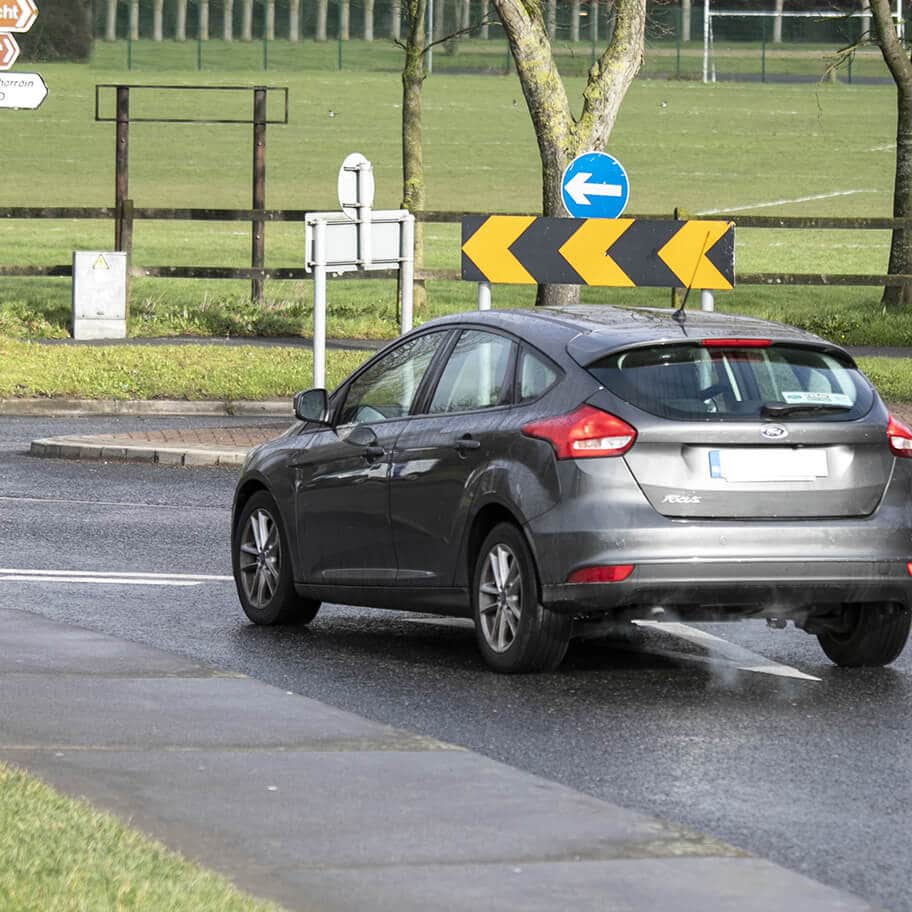Rules of the Roundabout
To safely navigate a roundabout a driver must be aware of their surroundings using good judgement and obey the rules of the road. In instances where the rules of the road are disregarded, it can increase the risk of a car accident.
Roundabouts are put in place to reduce traffic delays and minimise the risk of collisions. The rules of the road state that driver’s who are already on the road have priority. Collisions can happen when a driver does not check for oncoming traffic. The Road Safety Authorities (RSA) details the rules of the roundabout using a ‘clock system’ which will help driver’s to avoid collisions:
- When taking any exit from the 6 o’clock to the 12 o’clock position, motorists should generally approach in the left-hand lane.
- If taking any exit between the 12 o’clock to the 6 o’clock positions, motorists should approach in the right-hand lane.
- Follow any road markings or signs that are applicable to you.
- Keep to the right on the roundabout until you need to change to the left lane and exit the roundabout. Signal left after you have passed the exit and are nearing closer to the desired turnoff.
Common Injuries
Some of the common injuries sustained from a roundabout accident claim include:
Causes
Many accidents occur when a driver is inexperienced or does not understand how to enter a roundabout correctly. Common accidents on a roundabout are:
Collisions When Entering
The vehicle entering the roundabout fails to yield to oncoming traffic and causes an accident.
Sideswipe Accidents
A vehicle misjudges the curve of the roundabout and veers into the wrong lane and collides with another vehicle.
Rear-end Accidents
When a driver in front slows down unexpectedly, it can cause the driver behind to collide with their vehicle.
Collisions When Exiting
When a vehicle tries to exit the roundabout and cuts another vehicle off causing an accident.
What to do after a road traffic accident?
Following a road traffic accident, whether as a driver, passenger, pedestrian or cyclist, there are a number of steps you should follow:
-
Seek medical attention
Your health is your wealth and should be your first priority. Immediately after a road traffic accident, take a second to assess yourself to determine if you have any injuries. Then check if any passengers or anybody else involved in the accident need medical attention. If you or anyone else involved has sustained a serious injury ensure that you contact an ambulance to attend the scene.
For minor injuries, you must remember that minor injuries where you ‘feel fine’ could progress to a more serious injury in the future. In this case it is always better to be safe than sorry and advisable that you go to your nearest accident and emergency (A&E) or local GP to be checked out.
-
Gather all relevant information at the scene
It is important that you gather all the relevant information in connection with your accident:
- Details of another driver(s)/people involved: name, address, contact information, vehicle registration number and vehicle insurance information. You can also offer your own information to the others involved in the accident.
- Name and contact details of any emergency service workers at the scene – paramedic/Gardaí.
- Take a picture of the scene and damage to all vehicles involved from different angles; this will help your solicitor understand how the accident happened.
- If there are any CCTV recordings of the accident, such as CCTV cameras in a nearby shop, for example, you should try to obtain this footage.
- Dash Cam footage – if you have any.
- Record the time and date of the accident.
- Weather conditions at the time.
- Receipt for repairs of damage to your vehicle.
- If possible, try to collect the contact details of anybody that witnessed the accident. This may be of use if you do decide to pursue a road traffic accident claim.
-
Report the incident to the Gardaí
Regardless of how minor or serious the road traffic accident was, it is important that you call the Gardaí to report the accident immediately.
For minor accidents, the Gardaí may tell you that they will not be attending the scene. In this scenario, the appropriate information should be exchanged. In these cases, it is also important that you visit your nearest Garda station to request that they take details of the accident and to take your statement about the accident.
For more serious road traffic accidents, where an ambulance has been called, the Gardaí may arrive at the scene to assess, take statements from the people involved and any witnesses.
-
Contact your insurance company
If you are the driver of the vehicle involved in a road traffic accident it is important to inform your own insurance company so they have a record of the accident.
-
Speak to a road traffic accident solicitor
If you are considering moving forward with a road traffic accident claim for any personal injuries sustained it is advisable that you speak with a road traffic accident claims solicitor as soon as possible. If you are proceeding with a claim, the first step will be submitting your claim to the Injuries Board for assessment. A road traffic accident solicitor can help you in preparing your application to the Injuries Board and ensure that you follow the process in the correct format, meaning that you can move forward with your claim quickly without unnecessary delays.
It is important to remember to keep copies of any expenses that you have incurred as a result of the accident. It is also imperative to retain copies of medical reports or Garda reports, where possible as you will need them when making a claim.

